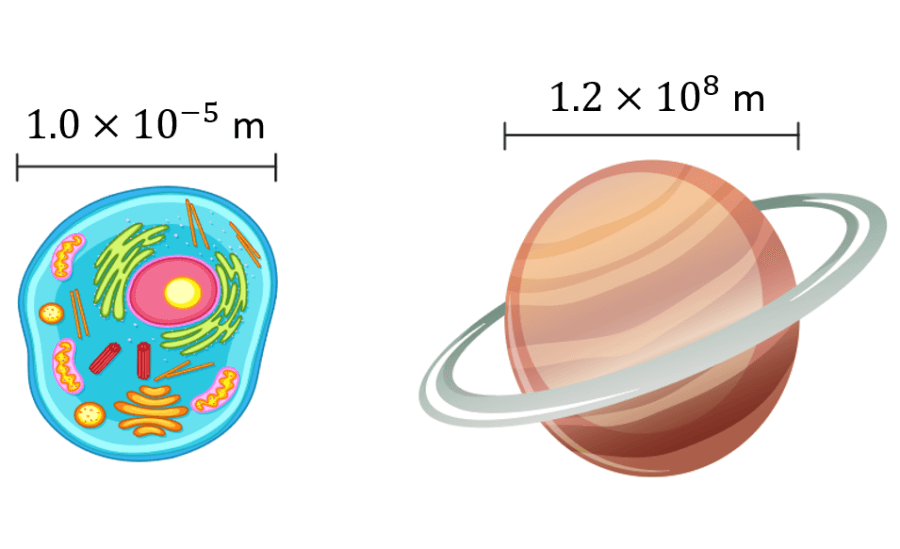Scientific notation allows us to write very large numbers or very small numbers in a more convenient way. Scientific notation is widely used by engineers and scientists. In this article, we will explore a summary of scientific notation. In addition, we will look at several examples with answers to improve our understanding of the concepts.
Also, we will look at some exercises to solve and practice what we have learned.
Summary of scientific notation
Scientific notation is the way scientists and engineers handle numbers that are very large or numbers that are very small. For example, instead of writing 0.0000045, we write $latex 4.5\times{{10}^{- 6}}$.
We can think of the number $latex 4.5 \times{{10}^{- 6}}$ as the product of two numbers: 4.5 (the digit term) and $latex {{10}^{- 6}}$ (the exponential term). The following are some examples of scientific notation:
| $latex 1000=1\times {{10}^3}$ | $latex 4562=4.562\times {{10}^3}$ |
| $latex 100=1\times {{10}^2}$ | $latex 251=2.51\times {{10}^2}$ |
| $latex 10=1\times {{10}^1}$ | $latex 42=4.2\times {{10}^1}$ |
| $latex 1=1\times {{10}^0}$ | |
| $latex 0.1=1\times {{10}^{-1}}$ | $latex 0.41=4.1\times {{10}^{-1}}$ |
| $latex 0.01=1\times {{10}^{-2}}$ | $latex 0.024=2.4\times {{10}^{-2}}$ |
| $latex 0.001=1\times {{10}^{-3}}$ | $latex 0.0065=6.5\times {{10}^{-3}}$ |
The exponent of 10 is the number of places that the decimal point must be moved to get the number in long form. A positive exponent shows that the decimal point is shifted that number of places to the right. A negative exponent shows that the decimal point is shifted that number of places to the left.
Scientific notation – Examples with answers
The following examples with answers can be used to improve understanding of the concepts. The reasoning in the solution of each exercise is useful to be applied to other similar scientific notation problems.
EXAMPLE 1
Write the number 34100000 in scientific notation.
Solution
In scientific notation, the digit term indicates the number of significant figures in the number. The exponential term only places the decimal point.
In this case, the given number only has 3 significant figures. The zeros are not significant, the zeros only occupy one place. Therefore, we move the decimal point 7 places to the left and we have:
$latex 34100000=3.41\times {{10}^7}$
EXAMPLE 2
Write the number 0.00041 in scientific notation.
Solution
In this case, the given number only has 2 significant figures. Now, we move the decimal point 4 places to the right and we have:
$latex 0.00041=4.1\times {{10}^{-4}}$
EXAMPLE 3
Write the number 568200000000 in scientific notation.
Solution
Here, we have a number with 4 significant figures. In this case, we have to move the decimal point 11 places to the left, so we have the following:
$latex 568200000000=5.682\times {{10}^{11}}$
EXAMPLE 4
Write the number 0.00000345 in scientific notation.
Solution
The given number has 3 significant figures. Also, we have to move the decimal point 6 places to the right. By doing this, we get the following:
$latex 0.00000345=3.45\times {{10}^{-6}}$
EXAMPLE 5
Add the numbers $latex 5.321\times {{10}^{-2}}+4.5\times {{10}^{-4}}$.
Solution
To perform a sum of numbers written in scientific notation, we have to make sure that all the numbers are converted to the same power of 10. Once the numbers have the same power of 10, we simply add the digit terms:
$latex 5.321\times {{10}^{-2}}+4.5\times {{10}^{-4}}$
$latex =5.321\times {{10}^{-2}}+0.045\times {{10}^{-2}}$
$latex =5.366\times {{10}^{-2}}$
EXAMPLE 6
Subtract the numbers $latex 6.67\times {{10}^4}-3.61\times {{10}^{3}}$.
Solution
Similar to the previous exercise, we have to have the same power of 10 in both numbers to be able to subtract. After converting them to the same power, we simply add the digit part:
$latex 6.67\times {{10}^4}-3.61\times {{10}^{3}}$
$latex =6.67\times {{10}^4}-0.361\times {{10}^{4}}$
$latex =6.31\times {{10}^{4}}$
EXAMPLE 7
Multiply the numbers $latex (3.4\times {{10}^6})(4.2\times {{10}^{3}})$.
Solution
The digit part is multiplied in the normal way and the exponents are added. The final result is changed so that there is only one non-zero digit to the left of the decimal:
$latex (3.4\times {{10}^6})(4.2\times {{10}^{3}})$
$latex =(3.4)(4.2)\times {{10}^{6+3}}$
$latex =14.28\times {{10}^{9}}$
$latex =1.4\times {{10}^{10}}$
Scientific notation – Practice problems
After having reviewed the examples with answers, try to solve the following scientific notation problems. Simply choose an answer and select the “Check” button to check your chosen answer. If you are having trouble with these problems, you can look back at the above examples carefully.
See also
Interested in learning more about algebraic topics? Take a look at these pages:




